Immigrants from Arab countries constitute up to 20% of the population of some Scandinavian cities. Their population in individual countries of the region is in the hundreds of thousands. How did it come about and what are the consequences?
Earlier this year, the Muslim Foundation in the Swedish city of Växjö applied to the police for permission to broadcast a three-minute call to Islamic prayer every Friday from a loudspeaker at a mosque in the Araby district. “We just want Sweden to allow the Muslims in Växjö so that they can feel more at home. The Muslim community should be proud of its culture and not feel that it has to hide, ”said local imam Ismail Abu Helal. "Muslims are not guests in Växjö, we live here," he added.
This is not the first such statement by a representative of the Islamic community in this country. In 2013, Imam Malmö Adly Abu Hajar's statement, who called Sweden "the best Islamic state", became famous. Indeed, the country ranks first in Scandinavia in terms of the number of permanently resident Muslims.
about 460,000 of them live there, which is 4.6% of the population . On the other hand, about 250,000 followers of the Prophet live in Norway, i.e. 5% of the total population, and in Denmark - over 200,000, which makes 4.1% of the population (they are also the second largest religious community there). Where do these large numbers come from?
Europe needs workers
After World War II, the western and northern parts of Europe entered a period of dynamic economic development. Reconstruction supported by American money from the Marshall Plan fueled the boom. Production and sales grew, and so did the GDP and wages of workers. Societies grew wealthier. Post-war Germany, France and the Benelux countries became symbols of economic success. At some point, however, it turned out that the economy was short of work. Immigrants have become the antidote to this problem.
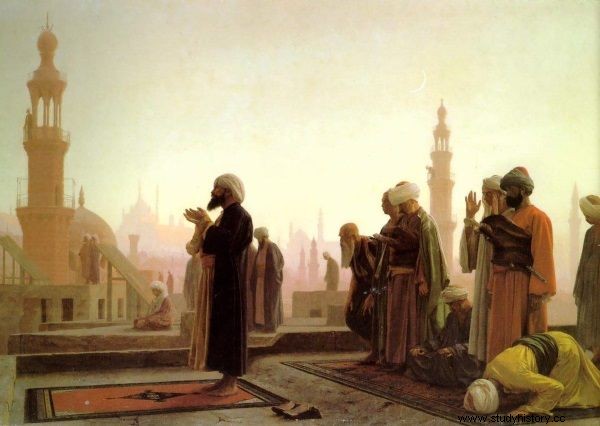
Mosques have been the place of prayer for the Muslim community for centuries. Currently, Muslims who emigrated to Europe claim the right to build Islamic sacred buildings.
Great Britain, France, the Netherlands, Belgium, and Sweden began to invite third world nationals, including many Muslims, to visit them. They were employed in industry, construction and services. The faster the economic development, the greater the demand for them. With time, the inhabitants of poor countries, including Arab countries, encouraged by the high standard of living in Western Europe, began to look for a better future on the Seine, the Thames and the Tiber. There is one more factor to that.
In the 1970s and 1980s, it turned out that affluent Western societies were starting to age. The stronger the need for an influx of young people from abroad was felt.
Thus, in the countries of western and northern Europe, Muslim communities of hundreds of thousands, and now even millions of people (at least in France and Germany) emerged quickly. As the economy changed, their situation began to worsen. The reduction of big industry employing cheap labor has led to the fact that most Islamic immigrants no longer have jobs in the West ...
Over time, the attitude of the immigrant population also changed. While the first generations tried to blend in with the new society as quickly as possible, the next - disappointed with poverty, unequal opportunities and informal, though still present discrimination - turned against it. Frustrated by unemployment and the lack of prospects, young Muslims have increasingly come into conflict with the law, and in recent years have turned to religious radicalism.
Scandinavia is rich and caring
Similar processes also took place in the Scandinavian countries:Denmark, Sweden and Norway. During World War II, these countries avoided damage, thanks to which their economic development was even faster. Sweden even made a profit in the war:it was not involved in hostilities, but traded profitably with all sides, building its prosperity.
No wonder that in the post-war period Scandinavia became one of the richest regions in Europe and the world. Thanks to high income, the local authorities could afford to create an extensive social welfare system for their citizens. The welfare states created in this way attracted emigrants from all over the world, including Arab countries.
An additional incentive for newcomers was the openness and liberalism of northern societies. Individualism and an attitude towards self-fulfillment ruled out forcing immigrants to adopt local values. Their religious difference did not seem too important to the secularized inhabitants of Scandinavia. The long rule of the Social Democrats emphasized rather on tolerance, the development of civil liberties and liberties, and social issues.
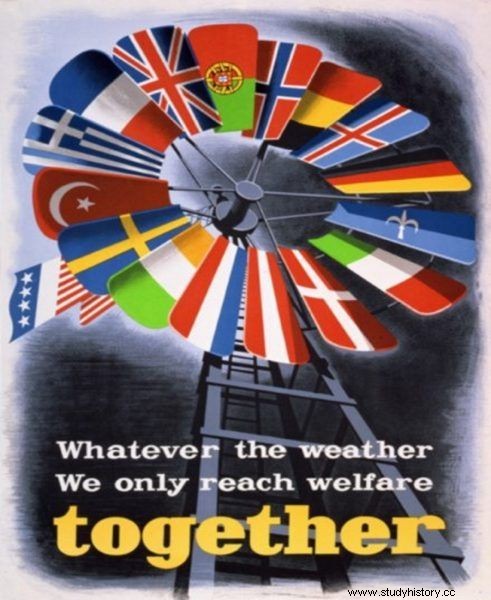
The scale of destruction in the Scandinavian countries after World War II was lower than in Western Europe. Nevertheless, these countries were included in the so-called "Marshall Plan".
This approach, of course, also embraced the followers of Islam. This is clearly seen in Sweden. The Muslims came to this country in four main waves. The first took place after World War II and mainly involved Turkish Tatars. The second one appeared in the 1960s, and it was made up of Yugoslavs, Turks, Albanians and Pakistanis. The third, in the 1980s, consisted mainly of political refugees from Iran, Iraq and Lebanon. The fourth took place in recent years and included refugees from war-torn Syria, Iraq, Afghanistan and African countries. As Professor Agnieszka Gromkowska-Melosik from Adam Mickiewicz University in Poznań writes:
The main reasons for Muslim immigration to Sweden are economic reasons, i.e. economic emigration and the benefits of living in a welfare state, the so-called welfare state. The second reason is related to political exile, where Sweden with its policy of openness has always been a symbol of asylum for the politically persecuted .
Assimilation? Not necessarily
What is the said policy of openness about? It is assumed that "an individual has the right to make his or her own decision on whether to confirm his or her original cultural (including ethnic) identity or adopt a Swedish identity". So assimilation is not required! You can stick to your culture and religion.
Not only that, it is even permissible to isolate oneself from local values. All this makes Sweden willingly and willingly chosen by Muslims. Especially that the traditionally liberal approach of the authorities allows them to obtain new rights and privileges for the local Islamic communities.
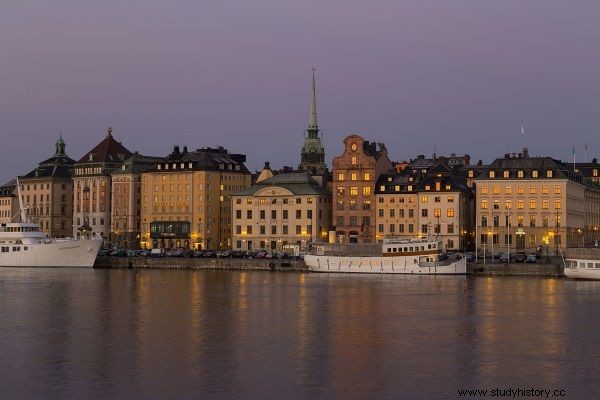
Among Swedish cities, Stockholm (pictured) and Malmö are very popular among Muslims.
Currently, Muslims in Sweden are concentrated in the three largest cities of the country:Stockholm, Gothenburg and Malmö. The last of them is inhabited by 80,000 followers of Islam. This is as much as 25% of the city's population! This is the highest percentage in all of Scandinavia. One of the districts, Rosengård, has been almost fully inhabited by immigrants from Arab countries.
In turn, in the second largest city in Sweden, Gothenburg, the followers of the Prophet Muhammad are almost 20%. population. In Stockholm alone, more than half of the entire Swedish Islamic community lives. Entire suburbs of the capital, such as Rinkeby, Husby and Norsborg have become closed neighborhoods where citizens of other faiths are often afraid to visit.
Denmark was also eager to open its doors to Muslims. In 2014, this country accepted the largest number of immigrants from all European countries. They were offered very good social conditions:$ 1,600 a month per person or over $ 4,000 for a family, provided that their parents were over 30. However, many visitors took advantage of this system, collecting benefits and reluctant to work.
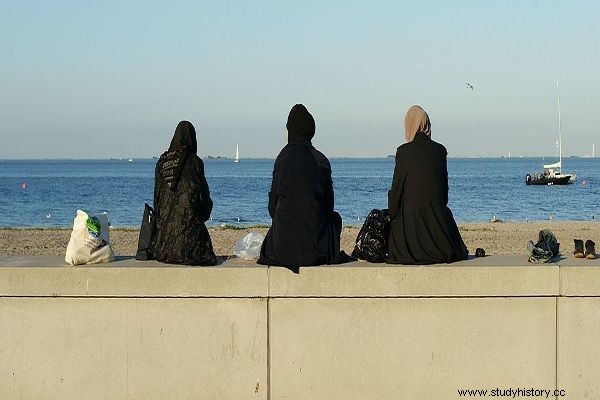
In Denmark, Muslim families can count on financial support, which encourages them to emigrate.
Families with many children made it simply a way of life. As in France, Germany and Sweden, Muslim ghettos have been set up in Danish cities. The population lives in isolation in them, not integrating, and sometimes even openly disregarding the law of the state that adopted them.
End of innocence
Unfortunately, the large number of Muslims is gradually becoming more and more problematic for the Scandinavian countries. Unassimilated communities become a base for Islamic radicals. This is where candidates are recruited to carry out terrorist attacks and fight in Islamic State troops. Radicals appear in Swedish ghettos. This is what he tells about their activities in the book "Shots in Copenhagen" Swedish journalist Niklas Orrenius:
They are playing a double game. When they are interviewed in the Swedish media, they say they are in favor of integration and building bridges. In turn, during lectures for Muslims, they oppose all forms of dialogue. They are attacking Swedish society.
The same author draws attention to the case of the city of Örebro, which has become one of the largest recruitment bases in Sweden for Islamic State. "In recent years, more than twenty young men and women from the city have traveled to Syria to join ISIS or al-Qaeda-related extremist organizations," writes Orrenius.
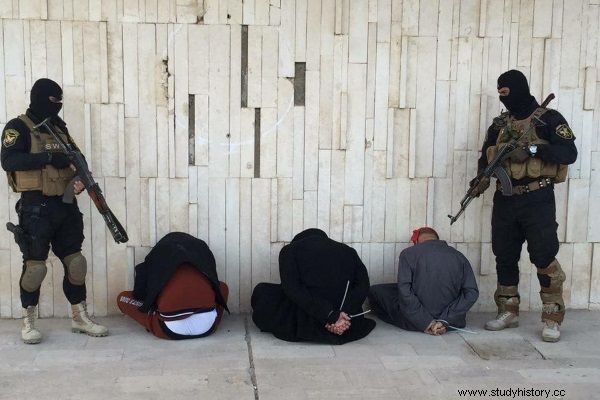
The Islamic State is looking for its recruits among the masses of Muslim emigrants. In recent years, this has aroused the vigilance of the security services, which are trying to solicit terrorist attacks.
Radical Islamists are gaining a stronger and stronger position in the country. When Swedish artist Lars Vilks drew a caricature of Muhammad as a dog in 2007, several attacks were made on him. So he was placed under strict protection by the police and is hiding like another creator - Salman Rushdie, chased by terrorist Muslim organizations. As he said in an interview with the author of "Strzałów w Copenhagen":
I am not a free man. Look where we're sitting. This place is very much like a jail. I'm locked up, I can only go out in the company of a guard. A short walk and back inside. And if I have to see someone, everything has to be planned.
"Vilks is a prisoner in his own country," comments Orrenius. He himself considers the isolated and radicalized Muslim communities in Sweden as a serious threat to the state and society. Others react similarly. In recent years, the Scandinavians' tolerant attitude towards immigrants has started to change. Right-wing political groups demanding the removal of Islamists and a halt to immigration are on the rise. And the policy of openness is becoming less and less popular…
